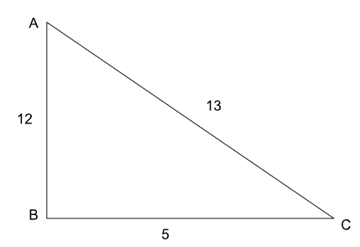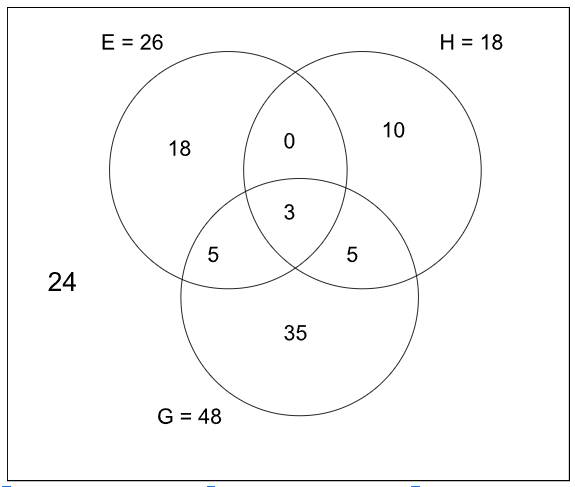JIPMAT 2023 Question Paper
For the following questions answer them individually
JIPMAT 2023 - Question 21
If the pair of linear equations $$2x + 3y = 7$$ and $$2px + (p + q)y = 28$$ has an infinite number of solutions, then $$(p, q)$$:
JIPMAT 2023 - Question 22
In $$\triangle ABC,\angle B = 90^{o}, BC = 5 cm, AC - AB =1 cm$$, then $$\frac{1 + \sin(C)}{1 + \cos(C)}$$ is
JIPMAT 2023 - Question 23
In a survey of 100 students, the number of students studying various languages were found to be:
1. English only-18
2. English but not Hindi-23
3. English and German-8
4. English-26
5. German-48
6. German and Hindi-8
7. No language-24
Then, which of the following statements are true?
A. Number of students who were studying Hindi is 18.
B. Number of students who were studying English and Hindi is 3.
C. Number of students who were studying English, Hindi and German is 3.
JIPMAT 2023 - Question 24
Amicable numbers are a pair of distinct natural numbers (a, b) such that the sum of the proper divisors of a equals b and the sum of the proper divisors of b equals a. Given that (220, y) is a pair of amicable numbers, y equals:
JIPMAT 2023 - Question 25
Given below are two statements in the context of throwing two different dice together:
Statement (I): The probability that the two numbers obtained have an even sum is 0.50.
Statement (II): The probability that the two numbers obtained have an even product is 0.75.
In light of the above statements, choose the most appropriate answer from the options given below.
JIPMAT 2023 - Question 26
The expression $$2x^{3}+ax^{2}+bx+3$$ where a and b are constants, has a factor of x-1 and leaves a remainder of 15 when divided by x + 2. Then, (a, b) =
JIPMAT 2023 - Question 27
Aman takes half the time rowing a certain distance downstream than upstream.
Statement (I): Ratio of the speed of the boat in still water to the speed of the water current is 2:1.
Statement (II): If the speed of the boat in still water is 6 km per hour, then the speed of the water current is 2 km per hour.
Choose the most appropriate answer from the options given below.
JIPMAT 2023 - Question 28
The probabilities that A, B, and D can solve a problem independently are $$\dfrac{1}{3},\ \dfrac{1}{3}\ \&\ \dfrac{1}{4}$$ respectively. The probability that only two of them are able to solve the problem is:
JIPMAT 2023 - Question 29
Given below are two statements:
Statement (I): $$(x^{2}+3x+1)=(x-2)^{2}$$ is not a quadratic equation.
Statement (II): The nature of roots of quadratic equations$$x^{2}+2x\sqrt{3}+3=0$$ are real and equal.
In light of the above statements, choose the most appropriate answer from the options given below.
JIPMAT 2023 - Question 30
Two identical solid cubes of side 5 cm are joined end to end. Then the total surface area of the resulting cuboid is:



